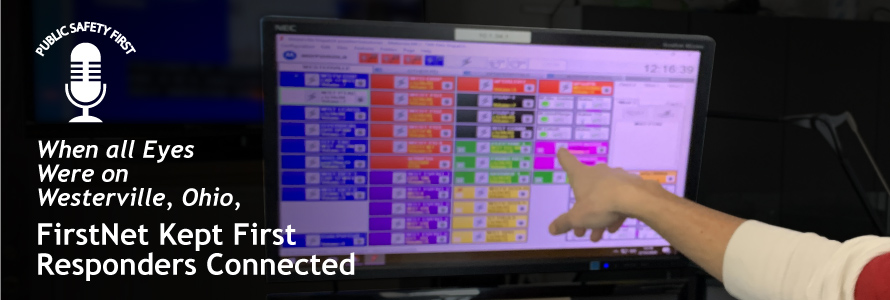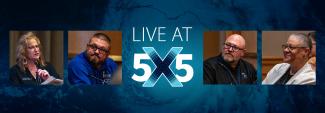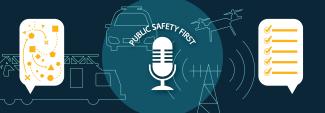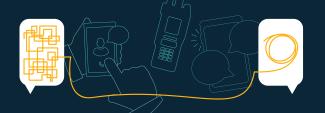Summary
When Otterbein University in Ohio played host to the 2019 Democratic presidential debate, thousands flocked to the City of Westerville to attend. During the event, the Westerville Police Department used FirstNet and drones to capture live, high-definition video and relay it to the emergency operations center, improving situational awareness and decision making.
Guest
Kyle Richardson
FirstNet Authority Senior Public Safety Advisor
Steve Morlan
City Communications Coordinator, Westerville, Ohio
Transcript
Preview
Narrator: You're listening to Public Safety First, a podcast to help you learn about the First Responder Network Authority and how you can be part of the future of public safety technology.
And now, your host.
Kyle Richardson: Welcome to the Public Safety First podcast. I’m Kyle Richardson, and I serve as Senior Public Safety Advisor with the First Responder Network Authority. I’m joined today by Steve Morlan, the City Communications Coordinator for the city of Westerville, Ohio. Steve has an extensive history in emergency dispatch and served as a critical component to the city of Westerville being an early adopter to FirstNet. We are pleased that he could join us today. Welcome to the podcast, Steve.
Steve Morlan: Thank you.
Narrator: You're listening to Public Safety First, a podcast to help you learn about the First Responder Network Authority and how you can be part of the future of public safety technology.
And now, your host.
Kyle Richardson: Welcome to the Public Safety First podcast. I’m Kyle Richardson, and I serve as Senior Public Safety Advisor with the First Responder Network Authority. I’m joined today by Steve Morlan, the City Communications Coordinator for the city of Westerville, Ohio. Steve has an extensive history in emergency dispatch and served as a critical component to the city of Westerville being an early adopter to FirstNet. We are pleased that he could join us today. Welcome to the podcast, Steve.
Steve Morlan: Thank you.
Kyle Richardson: Can you tell us a little bit more about your background and what your current role is?
Steve Morlan: I’ve been in public safety for 24 years. I started out dispatching with the Franklin County Sheriff’s Office and, for five years, and then came over here for 19 years – dispatched, and then moved into my new position.
Kyle Richardson: So, tell me now about how the city of Westerville is using FirstNet.
Steve Morlan: So, we have a population of 39,000, small suburb of Columbus. We first started out by using it for data in the cruisers, and it was just a test, and we only did one car, and we liked it. It provided everything we needed. So, we eventually put it in all of the cruisers. We use it for the CAD [computer-aided dispatch], mapping, and the in-dash camera, I believe, uploads through it when they come back into the station. So, and connectivity issues haven’t been an issue at all, so.
Kyle Richardson: Did you have any issues prior to coming on? Is there anything that prompted you?
Steve Morlan: Just what I was learning about FirstNet and how important it was going to be. So, didn’t want anything to go down, and they were purchasing modems, and when I saw the new one that came out that was FirstNet compatible, I kind of asked if we could get that one, and that’s when we started the test because it did dual SIM cards, and so, we tested them against other carriers.
Kyle Richardson: Yeah, we were walking through your facility here in Westerville, and that’s one of the things you reiterated is that, the redundancy piece of it.
Steve Morlan: Yes. So, I don’t like to work in panic mode. I like to plan ahead, so as many back-ups as I can get, or anything that will make my job easier, and everybody safer right off the get-go, that’s what I like. So, I plan for backups for radios, whatever the best company is for data, and that’s what I do.
Kyle Richardson: So, tell me about the end users. What’s been their experience?
Steve Morlan: Well, some of the officers have it on their personal phones, and they live out of the area, and they couldn’t get service before, and so, I had told them about FirstNet, they got on it, and they just kept thanking me about it and saying, “This is wonderful.” So, and actually, you know, that was the test bed originally, too, you know, we’ll do a couple of this first before we switch over – I mean, I wanted to test all the facets of it before we dive right in.
Kyle Richardson: So, have you had any applications that you have seen out there in the marketplace and said, “Hey, we need to get, we need to jump on this and start using it,” and have you put any of those onto the network?
Steve Morlan: Well, for our presidential debate, we brought in one of the Cell on Wheel trucks, and, because we had a population influx, and it was a national televised event, didn’t want anything to go wrong. So, I called the FirstNet rep, asked him to check the network. He checked the network, brought the truck down for me, we had some extra WiFi hotspots we spread out, just to beef up everything for us, and that worked out really well.
Kyle Richardson: Last October, October 2019, that was the fourth 2019 Democratic presidential debate, where thousands of people flocked to Otterbein University campus. Can you tell, tell me how public safety in your office planned for the safety and security for such a large event?
Steve Morlan: We only had three weeks’ notice to start it. We met with CNN, and that was on the police side, so I wasn’t involved in most of that until they had all that gathered up and then said, “Okay, here’s who we’re working with, this is what we want to do. Do it.” So, which we have an awesome drone team that we used. That was another thing we use FirstNet for was we had a SIM card we were shooting live video to the EOC [emergency operations center] through the drones that we had. And that was very valuable. Anywhere we wanted to go, or see something live, incident command could see it and have it move on somewhere else if something popped up, and the video was perfect.
It went off good. We ended up with eight departments. Franklin County Sheriff’s Office brought 150 deputies themselves. Delaware County, FBI, we had some HAZMAT military department, and a couple SWAT teams, bomb squad, joint terrorism task force. We had a lot of people here. We had to have a big police presence to, kind of, squelch what could happen, because we were looking at some of the protest videos from Houston and Detroit. We didn’t know what we were getting into — this is a small town.
Kyle Richardson: Yeah, that’s good that you were able to reach back to some other cities that have experienced the same thing and get some best practices. Now, what was the role of FirstNet in the planning process?
Steve Morlan: So, I called my FirstNet rep and told him, you know, “Hey, in three weeks, we’re having a debate, I don’t want data to fail, or the phones, if possible, so, can you check the network and do whatever you can to make sure that don’t happen?” So, that’s when he got the truck down here –
Kyle Richardson: And by truck you mean the deployable?
Steve Morlan: Yes, the Cell on Wheels. And they came early enough where, when the first position they were in, it wasn’t the best position for them, they found that out right away, and then we got them another spot that they liked because one of the buildings next to it was supposed to, it was scheduled to have 700 reporters in it. So, I mean, just, you can just imagine cell phone Armageddon, everybody. You know what’s going to happen.
Kyle Richardson: Yeah, so, that drone video, you showed at the Cincinnati forum we had, was incredible. It was just high definition, you were zooming in and you could really get close on it and provide that extra situational awareness for those in the EOC, and then, were you then pushing that out to devices or anything like that?
Steve Morlan: We pushed it out through YouTube Live, a private account so it wasn’t public or anything. It was coming straight into the EOC. They emailed the link, and then you could have it. Looking back, yeah, we could have pushed it out to the cruisers if we needed – anybody we sent the email to could basically pull it up. So, but we wanted to make sure the EOC had it.
Kyle Richardson: Yeah.
Steve Morlan: But yeah, we could have, with that connection that we had, we know we could have sent it anywhere.
Kyle Richardson: So, looking at that event as a baseline, what are you looking at for, enhanced capability?
Steve Morlan: The next thing I’d like to have is push-to-talk over, like our radios over the phones so that we could save money on radios for people that don’t want or need an $8,000 radio but has a smartphone and needs to talk on the radio, or monitor the radio. And I eventually would like to see a way to have mapping where we could actually map out where all of our people are in public safety. For EOC, that would have been nice to know where everybody’s at just by looking. And then, pushing out more to more people. So, the drone footage could have went to other people, as well, if needed, so.
Kyle Richardson: The features are continuing to roll out. The toolset is growing, as I like to say. We have the local control portal, with the ability to uplift, you know, your extended primary folk, or even going in for events ahead of time in a year in advance and presetting those. You have the Advance Network Status Tool. The toolset’s continuing to grow. You have the baseline of the network working, and it’s adding different features onto it – the FirstNet Push-to-Talk is coming soon. It’s a really exciting time for FirstNet users.
So, I wanted to ask you if you have any advice for any other agency who may be thinking about joining FirstNet. You know, you guys did your due diligence, is there anything that you might have for another agency that’s considering it?
Steve Morlan: Well, the deployables are free if you have an account, and if you can’t afford to go big, you can go small and still get an account and still have those tools available to you. At least give them a try and, you know, start out small with whatever you can do, and when you see the advantage that you’re going to get, then you can apply what you need to get permanently.
Always talk to the other departments. I had to borrow equipment from three different departments just to, just to make communications work. So, don’t be scared and plan ahead, especially for interoperability, whether it’s data or radios.
Kyle Richardson: Hey, what drives you, Steve, to do the work that you do, to come into this office day-to-day, and, you have such a big responsibility to keep everybody’s communications running – what drives you to do that? What’s your motivation?
Steve Morlan: Well, I guess I would have to say that I want to make sure that, well, with the radios, I want to make sure that it works correctly and never gets anybody hurt. So, and now that we’re mixing, you know, data and FirstNet and everything, you got to kind of make sure that everything’s going to work correctly and not get any of the first responders hurt. So, that’s what I think about every day when I come in, and I’m real anal about everything I do, just triple-testing everything to make sure that it works, because I don’t want to be responsible for anything happening.
Kyle Richardson: Yeah. Well, great job with the debate. Thanks so much for joining the podcast. We look forward to keeping this relationship going and continuing to meet your communications needs with FirstNet.
Steve Morlan: Great, thanks.
Narrator: Thanks for listening today. We're excited to have you join our podcast community. Make sure to subscribe on iTunes, SoundCloud, and YouTube. You can learn more about the First Responder Network Authority at FirstNet.gov and learn about FirstNet products and services at FirstNet.com.























